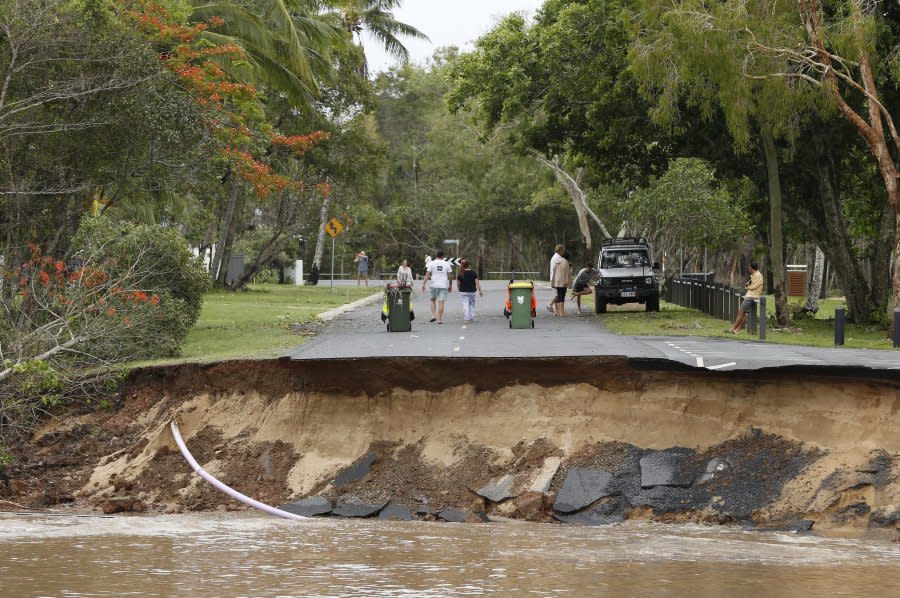Record breaking rains wreak flood havoc in Australia's far northeast

Dec. 18 (UPI) -- Record-breaking rains in northeastern Australia caused mass flooding cut power to thousands of homes and businesses and forced an evacuation order to be issued for at least one entire town, authorities said Monday.
Ex-tropical Cyclone Jasper battered northern Queensland over the weekend deluging parts of the state with more than 3 feet of rain over four days, smashing rainfall records that have stood for more than a century, according to Australia's Bureau of Meteorology.
"Overnight we have seen record-breaking rain across far north Queensland including flash flooding," Queensland Premier Steven Miles said in a press conference. "Far North Queenslanders know how to deal with natural disasters but this level of rainfall is next level."
Authorities postponed the aerial evacuation of Wujal Wujal's 275 residents to Cooktown 50 miles to the north by the military on Monday as record rainfall and dangerous flooding continued in the far north of the state.
"An attempt was made to aerially evacuate Wujal Wujal today but unfortunately the rain and cloud is still too strong," Miles said Monday afternoon.
"Another attempt is now planned for 8 a.m. [Tuesday], it's a very detailed plan underway for how to do that and then how to take care of them in the evacuation center."
Though rain has been easing throughout Monday, flood impacts remain, and the Bureau of Meteorology expects them to persist for a while with three major flood warnings still in place for the Daintree River, Murray River and Herbert River.
A fourth major flood warning had been in effect, but the waters of the Barron River have since receded.
The city of Cairns, which is home to some 150,000 people, has also been badly hit, with Miles stating in an update that with conditions too dangerous for air rescue operations, every single boat they could get their hands on has been deployed, mounting nearly 300 rescues from its northern beaches.
"Conditions around Cairns have been unsafe for aerial support -- as soon as conditions ease, we will move that support in," said Miles.
He added that emergency services were also using boats to get critical supplies into Cairns.
The city's airport remained closed but authorities hope to get it up and running again Tuesday, in part to be able to fly in supplies to the state where supplies are running low.
Captain Cook Highway between Port Douglas and Cairns, and the Bruce Highway linking Townsville with Innisfail both remain closed while about 13,000 homes across the region remain without power.
Miles said the state was making Disaster Recovery Funding available to nine councils in the far north allowing access to emergency grants of $121 for individuals, and up to $605 for a family of five or more, to cover the cost of essentials such as food, clothing and medicine.
During the press conference, he said authorities were also providing support to isolated and remote communities and were very concerned about Wujal Wujal and the neighboring town of Degarra.
He said nine people who were left stranded on the rooftop of a Wujal Wujal hospital had been safely moved to higher ground but that they, along with the entire town needed to be evacuated.
"While everything is being done to rescue them, the rain has been too heavy to get aerial support to them at this stage," Miles said.
"All people in Wujal Wujal are safe and we have a plan to evacuate them tomorrow morning if the weather is OK."
Miles added that though conditions were improving in northern Queensland by Monday evening, the area was not fully in the clear.
"It is still a serious weather emergency," he said.
State health agencies are also warning Queenslanders to beware of the risk of disease from contaminated floodwater.
Chief Health Officer Dr. John Gerrard cautioned that flood waters could cause bacterial diseases including leptospirosis. Symptoms include fever, severe headache, sore muscles, chills, vomiting and red eyes.
"If you're involved in the cleanup that is to come, wear water-resistant or enclosed footwear. Wash your hands with soap and water or hand sanitizer. Cover cuts, abrasions and wounds with a water-resistant dressing," said Gerrard.

